<Report from overseas office> [Thailand: World Residence Tour] Kitchen in Thailand (Bangkok)
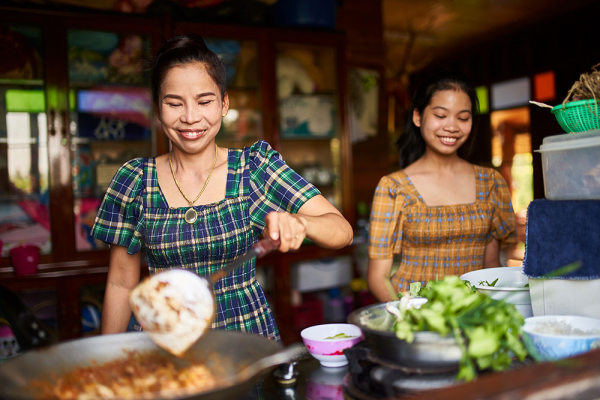
Introduction: COVID-19 in Thailand to date (as of April 2, 2021)
The Thai Ministry of Health and the Tourism Authority of Thailand announce the number of new COVID-19 cases only once a day, as of 11:30 a.m. The one on the left is from the Tourism Authority of Thailand and is in English so that foreigners can understand it. On the right is the announcement by the Ministry of Health, both of which can be found on Twitter.
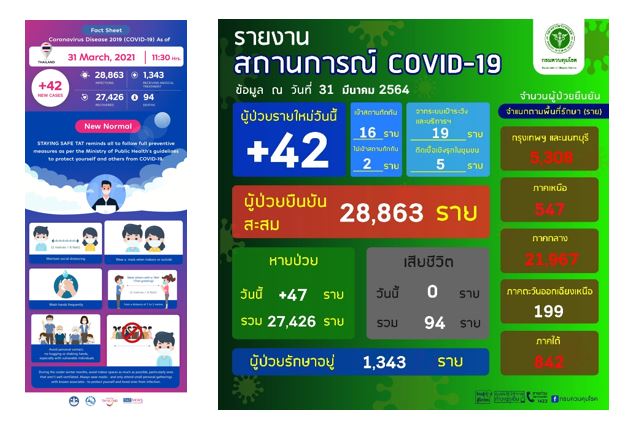
(Source: Left: Tourism Authority of Thailand Twitter, Right: Ministry of Health of Thailand Twitter)
There have been no consistent announcements or reports since the beginning of the COVID-19 outbreak to stir up public anxiety and confusion, although mild warnings have been given. As movement across borders and provincial borders was promptly banned, after a certain period of time, people who are now in their own living areas can have some confidence that they can be at ease with each other. In such a situation, companies continue to appeal for COVID-19 measures such as wearing masks, alcohol disinfection, and social distancing in a casual manner. Above all, we can't forget the situation we are in because our temperature is checked everywhere we go. Perhaps because of this, the daily life of the Thai people in the New Normal remains calm, and they are honestly living their lives by taking the COVID-19 measures that each of them should take.
During the lockdown period in the first half of 2020, it was not possible to eat out, and since I was basically working from home, one of the fads was to use the time I had to prepare meals at home. At the time, I was one of those who jumped on the bandwagon. However, after the lockdown is lifted in the middle of 2020, commuting will resume, and we will no longer have the time to cook meals at home, as we will have to eat out, take out, or deliver food prepared by someone else. On top of that, traffic congestion has recently taken away even more of our time. The increasingly long lines of customers buying prepared foods for dinner at street stalls in the city are a sign that more and more people are willing to pay for the time they are losing as COVID-19 becomes less of a concern.
As you can see, it was originally customary to "buy" meals, but during the COVID-19 lockdown in early 2020, Thailand was forced to cook meals at home. Let's take a look at how Thai kitchens are designed, using photos from three different households as examples. Please note that the photos I am going to introduce are not the ones I visited for the purpose of this column, so it is not clear if they are a complete reproduction of the usual conditions.
Thai Kitchen Part 1
The L-shaped kitchen of this family has a window on the right side for lighting and ventilation. The kitchen counter is lined with appliances, instant foods, supplements, bananas, etc., too much stuff to cook with.
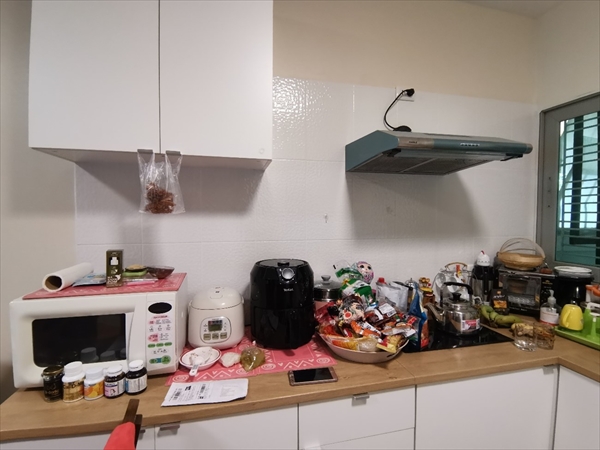
(Photo source: author's photo)
There are cups, mugs, mineral water, water purifiers, kettles, thermos bottles, instant coffee and coffee makers all in one place, and they are used like a drink counter. The black coffeemaker on the right side of the image above is integrated with a small toaster, but the toaster is not being used as a toaster, as it is filled with toy hamburgers. The kettle on the stove is used for the pile of instant noodles in the foreground to the left. A timer in the shape of a chicken is placed in the back right corner of the kettle, and a bell is placed on the left side of the kettle to let you know when the instant noodles are ready. A rice scoop with rice on it is placed in front of the rice cooker, so it seems that the rice is being cooked. The black appliance next to the rice cooker is an air fryer, and when I took a peek inside, I saw that it also contained toys. Air fryers are one of the cooking appliances that were popular during the COVID-19 lockdown, but they don't seem to be used much anymore. The kitchen in this home is generally set up as a snack corner and not a full-scale cooking area, in my eyes.
So, what would happen if we tried to do some serious cooking? First of all, the heat source is an electric stove, which is not expected to provide the sufficient heat required for Thai cooking. In addition, the range hood is installed at a relatively high place, so the smoke including oil generated from frying would not be effectively sucked out and would end up in the kitchen.
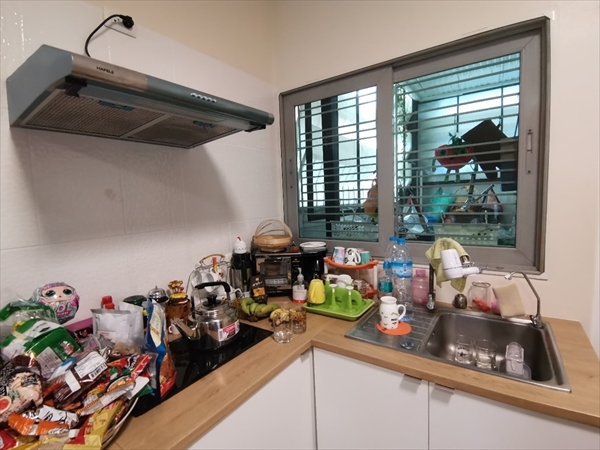
(Photo source: author's photo)
Thai Kitchen Part 2
It can be seen that the kitchen of this family does a lot of cooking compared to the kitchen in the previous section. One of the main differences between this kitchen and the previous one is that the seasoning set is conveniently placed next to the gas stove (at the back of the photo below). The sink is equipped with cleaning detergent, sponges, and rags. The cleaning tools are stored in a compartment right below the gas stove.
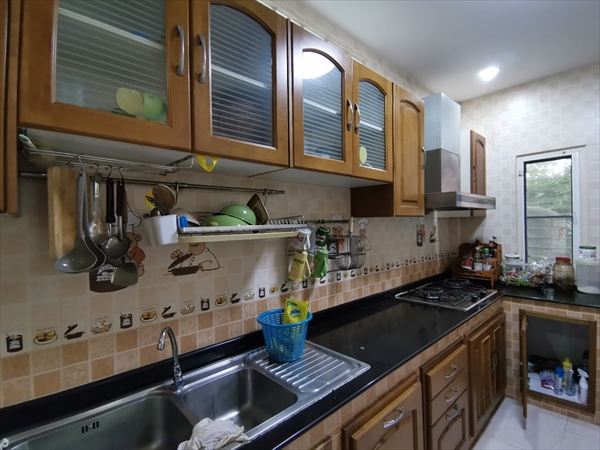
(Photo source: author's photo)
Across from the gas stove, various cooking utensils such as pots, rice cookers, frying pans, and crock (a bowl used for making som tam) are laid out bare. Not only in the kitchen, but I don't get the impression that they are very proactive about storing things in such a way that they can't be seen. In fact, this kitchen has a relatively good amount of storage space, but as you can see from the cleaning utensils (red circle in the photo below) under the right side of the stove, it is not packed tightly. I'm not sure if it's better to have invisible storage or not, which seems to be different from Japanese values at the moment.
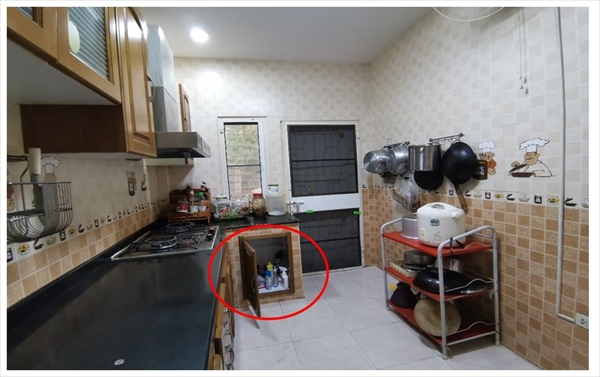
(Photo source: author's photo)
Thai Kitchen Part 3
The kitchen of this household is even more lifeless, inorganic, and bleak, but it is a common case. The water purifier has a stronger presence than the microwave oven. On top of the microwave oven is an electric kettle, but both the microwave oven and the kettle are unplugged, suggesting that they are not used that often. Even though the gas stove has a lot of heat, the range hood, which is only marginally attached to the stove, makes it look even more useless. In the first place, it is obvious that this gas stove is not in use when the microwave oven is installed perfectly on the gas stove. So where on earth are they cooking?
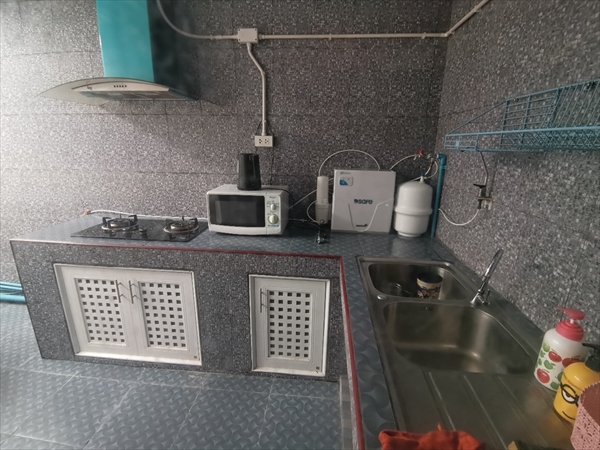
(Photo source: author's photo)
In townhouses and detached houses, it is not uncommon to have a "real kitchen" in addition to the indoor kitchen. This is not originally designed as a kitchen, but rather a semi-outdoor kitchen space in a converted garage or backyard. This way, you can cook without worrying about the huge amount of smoke that stains your eyes when you fry garlic or chili over high heat.
Propane gas, not electricity, is often used as the heat source, and burners like those used for commercial use are set up haphazardly. (Can you see the gas cylinder directly under the cutting board made of sliced wood near the center of the lower left photo, and the pot on the tripod-shaped pentode behind it?)
It is interesting to note that although we often see houses that have gone to the trouble of customizing their "real kitchens" in this way, the houses were not designed as such from the beginning. It is interesting to note that the houses were not designed as such from the beginning.
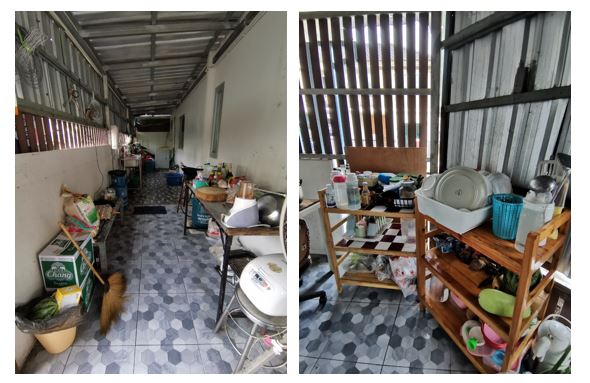
(Photo source: author's photo)
The blue tin area in the left foreground of the house on this corner corresponds to the outside of the kitchen mentioned earlier.
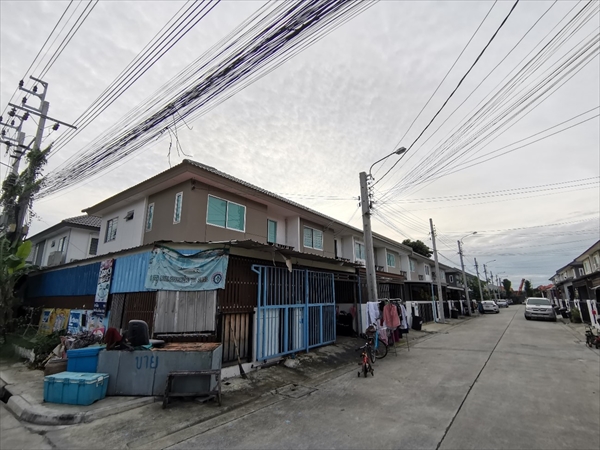
(Photo source: author's photo)
In fact, each of the kitchens introduced here has its own kitchen door, and if you go out of that door, you will find a kitchen that was created by this kind of renovation. In Thailand, where most women work, it is of course a rational choice to buy and bring home meals because they are fast, cheap, convenient, and delicious, but it is also true that they have taken the trouble to add cooking space in this way. However, it is also a fact that they have taken the trouble to add cooking space in this way. This does not mean that they do not cook because the indoor kitchen is poor.
[ Appendix ] Regarding the gas stove, here is a picture of another household that shows the relationship between the gas cylinder and the stove. In this picture, the burner and the pentode are directly above the cylinder. If you reduce the size of the stove, you will notice that it is the same concept as the gas stove that is often sold in Japan as camping goods. Originally, Thailand was a society of mobility of heat sources, and food was cooked using gas or charcoal regardless of the location, such as mobile food stalls and local food stores on the street. Given the social background of the development of these mobile cooking devices, it is not surprising that they are being used in the home as an extension of these devices.
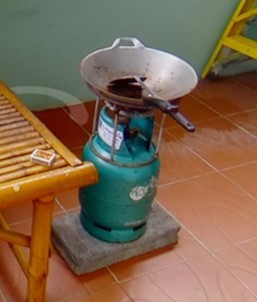
Source: Consumer Life Database (Consumer Life Panorama)
For an overview of Consumer Life Panorama (click here)
Introduction to Consumer Life Panorama
In addition to the kitchen introduced here, the inside of the house, which is not visible from the outside, is filled with many other discoveries. Since June 2020, Intage Thailand has been conducting all offline surveys, including home visits, without any problems, while keeping an eye on the COVID-19 infection status. It is of course possible to stream the interviews to Japan and other countries.
In addition, Consumer Life Panorama, a consumer database provided by Intage, provides 360-degree images of the inside of consumers' homes in Thailand and 10 other countries. This is a service that can be used to observe the living environment of people living overseas without the need for customized surveys, so if you haven't seen it yet, I highly recommend giving it a try.
The Consumer Life Panorama demo site can be found here.
An overview of Consumer Life Panorama can be found here.
Translated with AI Translator
-

Author profile
(Mr.) Daisuke Aoba
Male researcher in his 40s living in Thailand. He has visited more than 30 countries in the past. He seeks the best for the consumers in the country and always tries to match his feelings with theirs. He continues to post his own global gourmet posts, which are viewed about 1,000 times a day, mainly in Thailand.
-

Editor profile
(Ms.) Risa Takahama
- Apr 02, 2021
- 7946 Views
 Global Market Surfer
Global Market Surfer CLP
CLP